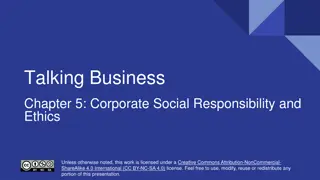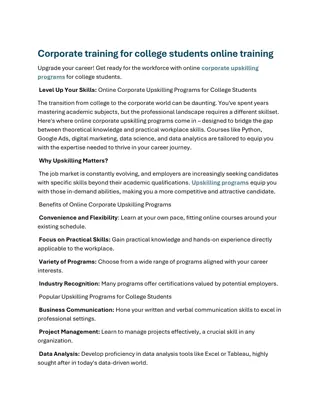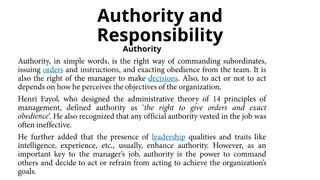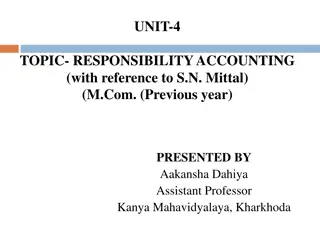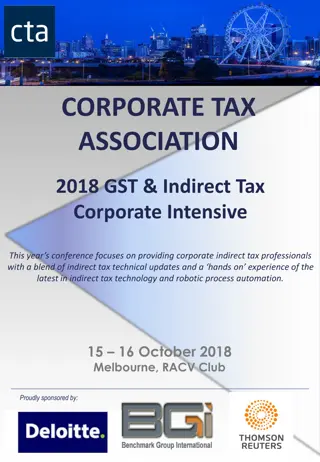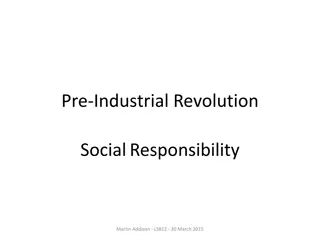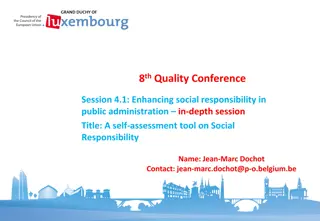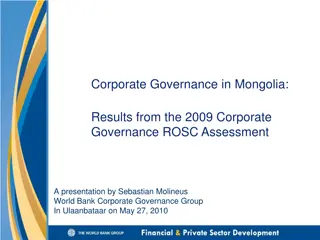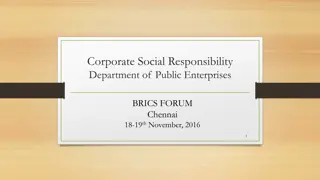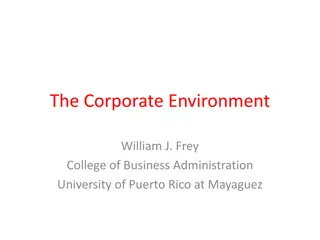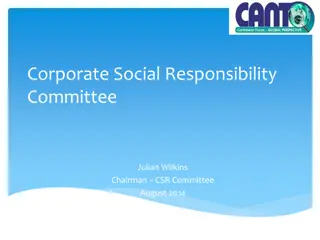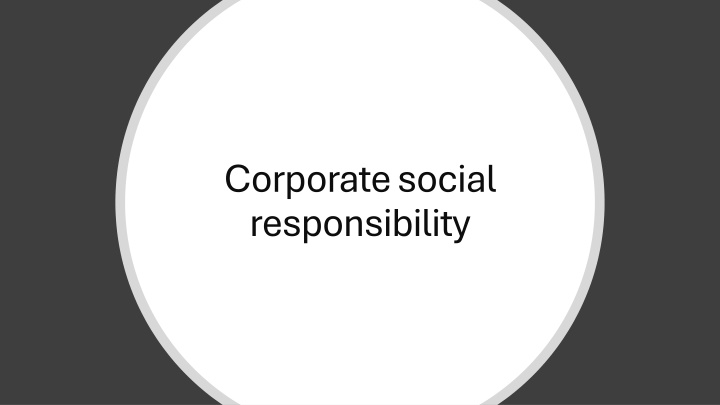
Corporate Social Responsibility in Modern Business
Explore the concept of Corporate Social Responsibility (CSR) and its significance in today's business landscape. Delve into key CSR issues within the realm of Human Resource Management (HRM) and grasp the core characteristics of CSR, including stakeholder orientation and economic alignment. Gain insights into classical views on CSR, such as the perspectives of Friedman and Carroll, and analyze arguments both for and against CSR implementation. Discover the global impact of business practices and the debate surrounding the role of profit in corporate social responsibility.
Download Presentation

Please find below an Image/Link to download the presentation.
The content on the website is provided AS IS for your information and personal use only. It may not be sold, licensed, or shared on other websites without obtaining consent from the author. If you encounter any issues during the download, it is possible that the publisher has removed the file from their server.
You are allowed to download the files provided on this website for personal or commercial use, subject to the condition that they are used lawfully. All files are the property of their respective owners.
The content on the website is provided AS IS for your information and personal use only. It may not be sold, licensed, or shared on other websites without obtaining consent from the author.
E N D
Presentation Transcript
Corporatesocial responsibility
Learning objectives Understand the importance of corporate social responsibility (CSR) and its different conceptualisations Understand key CSR issues in the context of HRM
CorecharacteristicsofCSR Multiple stakeholder orientation Managing externalities CSR Voluntary Social & economic alignment Beyond Philanthropy Practices & Values Crane, Matten & Spence (2014)
CSRperspectives Classical Friedman Contemporary Carroll Stakeholder - Freeman 5
ClassicalviewthecaseagainstCSR Economic behaviour different from other behaviours separation thesis. Different criteria of effective business performance. Primary goal and motivation of business is profit. 6
Classicalview -Friedman Friedman s (1970) arguments against CSR: Business executives do not have the right to further social interests by spending shareholders , customers or employees money Only people can have responsibilities. A corporation is an artificial person and in this sense may have artificial responsibilities, but business as a whole cannot be said to have responsibilities Business executives have the responsibility to conduct the business in accordance with the desires of the owners of the business make as much money as possible while conforming to the basic rules of the society, both those embodied in law and those embodied in ethical custom 7
Thecase againstCSRKarnani(2010) Karnani s arguments against: Companies that simply do everything they can to boost profits will end up increasing social welfare Problem - misalignment between private and public interests Executives choose profit - otherwise incompetent or selfish, corporate governance problem. How then should we ensure good corporate behaviour? 1. Regulation 2.Activism 3. Self-regulation 4. Punishment - financial 8
ThecaseforCSRSmith(2003) Global impact of business demands greater social responsibility least developed countries Enlightened self-interest Paternalism Reputational risk Societal expectations social license to operate (SLO) 9
Corporate social responsibility Carroll spyramid/fourfaces Philanthropic responsibilities Ethical responsibilities Legal responsibilities Economic responsibilities (Carroll 119091, 1998)
CorporateSocialResponsibilities Economic responsibilities Business produces goods and services, while making an acceptable profit. Without financial viability other responsibilities are dubious. Legal responsibilities Business expected to carry out its work lawfully. The law is at the floor of acceptable behaviour The law reflects minimum standards of behaviour Laws are not always up to date Laws may not address all relevant social issues Laws may lag behind ethical thinking (Carroll 1998) 11
Three domain approachSchwartz &Carroll(2003) Legal Legal Economic Legal Ethical Legal Economic Ethical Economic Ethical Economic Ethical Source: Schwartz and Carroll 2003, p.509) 12
EvolvingMeaningsofCSR earnestly bearing in mind the impact of the company s actions on societies. a commitment of decision makers to take actions that safeguard and improve the welfare of society as a whole, and the company s own interests. assumes that the corporation has economic and legal obligations as well as responsibilities to society that extend beyond these obligations.
CSR,EthicsandLeadership Whilst debate exists as to the role of business, most businesses embrace a range of CSR practices Ethics is important in business no separation provides a foundation to enable a prosperous society Boards of directors - role and responsibilities should embrace ethics (covered Workshop 8) and CSR Firm leadership crucial for CSR (and ethics)
EthicsandBadApples VW (emissions scandal) Enron every scandal imaginable) BHP Billiton (Ok Tedi/Brazil) Securrency (bribes) Commonwealth Bank Australia (Financial Planners and Insurance) National Australia Bank (Financial Planners) Foxconn (suicides) - Saradha Group (Ponzi Scheme Financial scandal) And there are many claims against other corporations in your own time please refer to http://anonhq.com/10-corrupt-corporations-alecs-dirt-hands/
TheWorld'sMost Ethical Companies2016 For the full list Please refer to http://www.forbes.com/sites/karstenstrauss/2016/03/09/the-worlds-mo st-ethical-companies-2016/#62a84de73dc0 Note: Forbes list the National Australia Bank. Have you been keeping up with the Royal Commission into the banking industry?
ClassActivity Thinking about your workplace, how is your own organisation engaged in CSR activities? Who is leading this activity and why? What are the benefits of this CSR activity and to whom? 18
ChangingAttitudesCSRand Business Ethics To meet the expectations of society, managers need to be more socially responsible Most large corporations have a code of ethics on their website 18
CorporateSocialResponsibility T o Trevino and Nelson (2011) there is an inferred, perhaps enforced, or personal obligation of managers, acting in their official capacity, to serve or protect the interests of groups other than themselves This is not always the case Let s think about this and discuss 19
Legislating Ethics and Social Responsibility Procurement IntegrityAct of 1988 passed after reports of military contracts for $500 toilet seats What other examples can you think of that have been outrageous acts by organisations or individuals within companies and what does this have to do with HRM Key Concepts? 20
StakeholderAnalysisandtheSocial Contract Organisational Obligations to: Stakeholders Social contract Individuals Other organisations Government & society in general 21
Diverse stakeholders with whom companies mayengage
5 key stakeholder groups and HR and other attendant issues Customers Communities Investors Suppliers Employees ethical sourcing, prompt payment, use of migrant and child workers, doing business with oppressive regimes andhumanrightsof outsourcedworkers product manufacturing (human rights of workers, product safety,safety standards),labelling and packaging, marketing and advertising practices, and pricing traditional philanthropy, community investment and development, partnerships betweenemployees and communities, environmental issues, and donationsto politicalparties identifying sources of socialand environmental risk recruitment &selection, compensation & benefits, training, occupational health & safety, work-life balance, diversity
Social Impact Planned appraisal and assessment of an organisation s activities in terms of its social impact 27
ExampleofHRMandSocialImpact The employment and support of workers with disability at the workplace Meacham, Cavanagh and Bartram (2018) (published in the Journal of Business Ethics) examines the employment experience of workers with intellectual disability (WWID) in the hotel sector inAustralia. Through a qualitative case study the authors interviewed managers and WWID, and held focus groups with supervisors and colleagues at three hotels. They used the theoretical framework of corporate social responsibility to investigate HR practices that create an ethical climate which promote authentic work experiences for WWID.
ExampleofHRMandSocialImpact The study found that participative work practices provide evidence of how WWID fit in at the workplace. When workers are confronted with work-related anxieties, the pragmatic nature of existential authenticity becomes a reality. Our findings reveal that managing workers ethically can lead to more authentic work experiences. In turn, this may promote social inclusion of WWID and improve their reported wellbeing.
TheNatureofaProfession Avocation characterised by the existence of: Aprocedure for certifying profession Acommon body of knowledge members of a 28
HR ProfessionalGroups Australian Human Resource Institute https://www.ahri.com.au/ CIPD - https://www.cipd.co.uk/ 32
CIPDsviewofCSR The role of HR in corporate responsibility At the CIPD, we believe that the HR function has a key role to play in embedding corporate responsibility in all aspects of the business. This can be achieved through various ways, including: 1 ensuring corporate responsibility is part and parcel of HR s strategy; 2 threading sustainability concerns through people management policies and practices; 3 developing management capability and promoting organisational learning in corporate responsibility; 4 ensuring alignment between the organisation s values, culture and business activity. It is in the last of these that HR is seen to have a unique role in corporate responsibility. Beyond its own remit of people management practices, it is ideally placed to be able to gauge, understand and help change organisational culture, the critical aspect to corporate responsibility that is often summed up as how we do things around here. Organisational culture runs through all aspects of a business and, in acting as its guardian, HR can act as a mirror of conscience to the rest of the organisation. (We recommend you download the full report: https://www.cipd.co.uk/Images/the-role-of-hr-in-corporate- responsibility_2013-sop_tcm18-9315.pdf 33
7processestobeincorporatedinto a company soperatingstructure Careful screening of personnel to whom authority is delegated appropriate & timely responses in cases of a violation Establishment of standards & procedures tailored to the needs, size & operating environment Communication of compliance standards & procedures to all employees & appropriate training Periodic auditing, monitoring & evaluation & implementation of internal consultative & reporting mechanisms Oversight by senior management Promotion & consistent enforcement through positive incentives & appropriate discipline
Corporate ethics programmes and HR Revising written standards of ethical business conduct in consultation with employees HR organise focus groups/workshops Ethical issues should not be limited to specific HR issues it should also include issues of primary concern to employees in their daily work practices HR should provide training about these standards HR should: undertake ethics training implement in-depth training programmes initiate creative and meaningful ways to link ethics and organisational values to performance management and reward programmes
CorporateGovernanceandHR Superior governance is identified in terms of transparency, accountability, responsibility and an independent overview of matters relating to corporate financial, ethical, social and environmental performance Traditional HR activities of recruitment and selection, training and development, performance management and remuneration have a critical role to play in the development and maintenance of good corporate governance practices; not only in terms of boards of directors, but also in improving shareholder value through the development of intellectual capital and upholding a company s responsibilities to stakeholders, in particular to its employees balanced board board remuneration monitoring and measurement of board performance
References Carroll, A., Buchholtz, A. 2015. Business & society : Ethics, sustainability, and stakeholder management (9th ed.). Mason, Ohio: South-Western/ Cengage Learning. Trevino, L. and Nelson, K. 2014. Managing Business Ethics: Straight Talk about How to Do It Right (6th Edition), John Wiley, USA Carroll, AB 1991, 'The pyramid of corporate social responsibility: Toward the moral management of organizational stakeholders', Business Horizons, vol. 34, no. 4, pp. 39-48. Carroll,AB 1998, 'The Four Faces of Corporate Citizenship', Business and Society Review, vol. 100, no. 1, pp. 1-7. Crane, A, Matten D & Spence, L (2014) Corporate Social Responsibility: Readings and Cases in a Global Context (2nd Edition), Routledge, New York, USA) Freeman, RE 2008, 'Managing for Stakeholders', in T Donaldson & PH Freeman, RE 2010, Strategic management : a stakeholder approach, Cambridge University Press, UK. 34
References Friedman, M 2007, 'The social responsibility of business is to increase its profits', in WC Zimmerli, M Holzinger & K Richter (eds), Corporate Ethics and Corporate Governance, Springer Berlin, pp. 173-8. Karnani, A (2010) 'The Case Against Corporate Social Responsibility', Wall Street Journal, 23August 2010. Margolis, J.D. and Walsh, J.P. (2003). Misery loves companies: Rethinking social initiatives by business.Administrative Science Quarterly, 48: 265-305. Matten, D & Moon, J (2008) Implicit and explicit CSR: a conceptual framework for a comparative understanding of corporate social responsibility,Academy of Management Review 33(2): 404-424. Smith, NC (2003) Corporate Social Responsibility: Whether or How?, California Management Review, Summer, Vol.45 (4), pp.52-76.Smith, NC (2003) Schwartz, MS & Carroll, AB (2003) Corporate Social Responsibility: A Three- DomainApproach , Business Ethics Quarterly, Vol. 13, No. 4 (Oct., 2003), pp. 503-530 35
References Chin, MK, Hambrick, DC, Trevi o, LK (2013) Political Ideologies of CEOs: The Influence of Executives Values on Corporate Social Responsibility. Administrative Science Quarterly, 2013, Vol.58(2), pp.197-232. DiMaggio, P.J., & Powell, W.W. (1983). "The Iron Cage Revisited: Institutional Isomorphism and Collective Rationality in Organizational Fields." American Sociological Review, 48(2), 147-160. Husted, B & Allen, DB (2006) Corporate Social Responsibility in the Multinational Enterprise: Strategic and InstitutionalApproaches, Journal of International Business Studies Vol. 37, No. 6, Husted, B, Allen, DB (2011) Corporate social strategy : stakeholder engagement and competitive advantage,
References Marquis, C, Davis, GF, & Glynn, MA (2013). "Golfing Alone? Corporations, Elites and Nonprofit Growth in 100 American Communities." Organization Science, 24(1): 39 57 Marquis, C & Battilana, J (2009) "Acting Globally but Thinking Locally? The Enduring Influence of Local Communities on Organizations." Research in Organizational Behavior, 29: 283 302. Mitchell, RK,Agle, BR, Wood, DJ. (1997) Toward a Theory of Stakeholder Identification and Salience: Defining the Principle of Who and What Really Counts ,Academy of Management Review, Vol.22(4), pp.853-886. Peng, MW., Wang, DYL & Jiang Y (2008). An institution-based view of international business strategy:Afocus on emerging economies. Journal of International Business Studies, 39 (5): 920-936.


